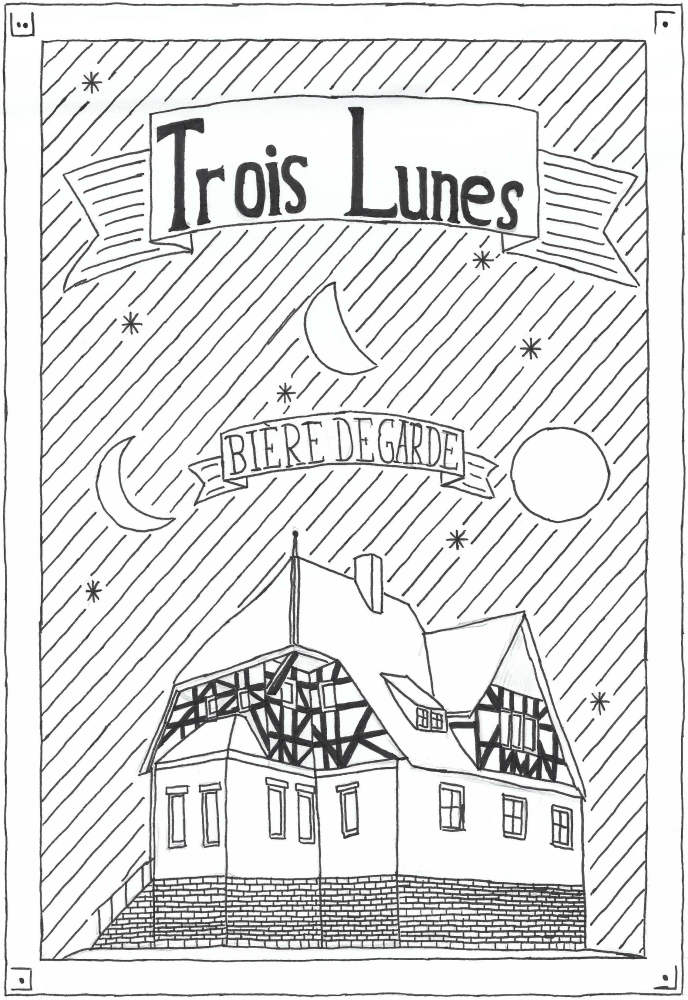
Ah yes, the Trois Lunes. This is Brudi's favorite beer and he is looking forward to brewing it every year. It is a strong farmhouse-style ale that is inspired by the northern French Bières de Garde. The translation of Bière de Garde is "Beer for keeping" and this describes the origins of this style perfectly. In pre-industrial northern France, beer was brewed on Farms and was an important part of the farm workers' salary. Before the invention of chillers and the breakthrough of Lager brewing techniques, it was too warm to brew in the summer. Therefore farmers brewed a stronger beer in spring and stored it until the summer. With the advent of Industrialization in northern France, Pilsener could be brewed all year round and the Bières de Garde in their traditional sense went extinct. The style was revived in the 20th century by the Duyck brewery. The original recipes for Bière de Garde were never really documented because apparently no brewing historian wanted to do research in old farmhouses. As a consequence, the modern style Bières de Garde are based on what brewers knew for a fact about traditional ones (long storage times, higher gravity, malt-forward) and modern brewing techniques fill in the gaps. Today's Bières de Garde do not have much to do with the traditional style but they are nonetheless very tasty. Three categories of Bière de Garde exist: Blonde (pale), Ambrée (amber-colored) and Bruin (dark brown). This shows that the style isn't one that's easy to summarize. It can cover nearly everything between a stronger Helles and an Imperial Stout. They all have a few things in common though: They are malt-forward, strong and have a clear flavor profile resulting from low fermentation temperatures and a long storage time.
The Trois Lunes is a Bière de Garde Ambrée. However Brudi interprets this style rather freely. Which is a nice way of saying that he does it COMPLETELY WRONG. Instead of a clear Altbier yeast he uses a peppery-spicy Belgian Saison yeast and instead of lagering the beer in a fridge for six weeks, he stores it for a couple of months in his basement at 20°C. As a result, his beer has a more robust flavor profile than one would expect from a Bière de Garde. It is however probably closer to the traditional style.
Bières de Garde are generally quite malty and heavy and should be drank from a chalice. If you don't have a chalice, a big red wine glass does the trick just as well and Pilsener tulips and pint glasses work okay too. A good serving temperature would be 8-10°C, so take the beer out of your fridge about half an hour before drinking it. We see a slightly hazy amber-colored beer with a tall, slightly off-white head. The aroma is dominated by the malts with notes of dark bread, biscuits and dried fruits. Slight aromas of banana and spice from the yeast are also present. The first impression on the palate is rather full-bodied but also effervescent. The flavor starts nutty and bready and changes to biscuity and fruity. The finish is dry and spritzy like a dark wheat beer in spite of its 7% ABV. This is made possible by the Saison yeas and a rather low final gravity of the beer. So be carful with it. It may feel light and spritzy but it has the punch of a Belgian strong ale.
Traditionally, Bières de Garde work very well with French food and its herb seasonings like Cassoulet or Ratatouille. Trois Lunes works equally well with Burgers or Barbecue. And for the ultimate Bière de Garde experience I recommend having a Trois Lunes in the evening after a day of harvesting hay in June. You never did that? Well do it, the beer is well worth it!.
Trois Lunes is made in a 25-liters kettle using the Brew-in-a-bag technique. For about 16 liters of beer you need the follwing ingredients:
The mash takes 90 minutes at 65°C using 20 liters of water. The water is filtered using a filter by Brita or equivalent. After mashing, two more liters of water are added. The boil takes 70 minutes and the hops are added as a bittering addition 60 minutes before flame out. Primary fermentation takes two weeks at about 18°C. For the secondary fermentation, the beer is bottled and primed with sugar equivalent to 2.5 units of CO2. It is stored for three months at about 20°C.